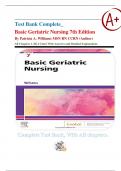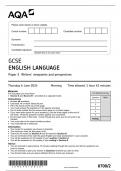Test Bank Complete_
Basic Geriatric Nursing 7th Edition
By Patricia A. Williams MSN RN CCRN (Author)
All Chapters 1-20| 4 Units| With Answers and Detailed Explanations
,UNIT ONE: OVERVIEW OF AGING ________________________________________________ 3
Chapter 1: Trends And Issues _________________________________________________________ 3
Chapter 2- Theories Of Aging _________________________________________________________ 7
Chapter 03: Physiologic Changes _____________________________________________________ 24
UNIT TWO: BASIC SKILLS FOR GERONTOLOGIC NURSING ____________________________ 50
Chapter 04: Health Promotion, Health Maintenance, And Home Health Considerations ________ 50
Chapter 05: Communicating With Older Adults _________________________________________ 76
Chapter 06: Maintaining Fluid Balance And Meeting Nutrition Needs ______________________ 105
Chapter 07: Medications And Older Adults____________________________________________ 133
Chapter 08: Health Assessment Of Older Adults _______________________________________ 148
Chapter 09: Meeting Safety Needs Of Older Adults _____________________________________ 176
UNIT THREE: PSYCHOSOCIAL CARE OF THE ELDERLY _______________________________ 190
Chapter 10: Cognition And Perception _______________________________________________ 190
Chapter 11: Self-Perception And Self-Concept _________________________________________ 214
Chapter 12: Roles And Relationships_________________________________________________ 240
Chapter 13: Copin And Stress ______________________________________________________ 264
Chapter 14: Values And Beliefs _____________________________________________________ 288
Chapter 15 End-Of-Life Care _______________________________________________________ 312
Chapter 16: Sexuality And Aging ____________________________________________________ 345
UNIT FOUR: PHYSICAL CARE OF THE ELDERLY _____________________________________ 370
Chapter 17: Care Of Aging Skin And Mucous Membranes ________________________________ 370
Chapter 18: Elimination ___________________________________________________________ 396
Chapter 19: Activity And Exercise ___________________________________________________ 419
Chapter 20: Sleep And Rest ________________________________________________________ 442
,UNIT ONE: OVERVIEW OF AGING
Chapter 1: Trends And Issues
Patricia A. Williams: Basic Geriatric Nursing 7th Edition Test Bank
MULTIPLE CHOICE
1. Since 1995 There Has Been A Significant Decrease In The Rate Of Infant Death
related To Which Of The Following:
A. Disorders Associated With Short Gestation And Low Birth Weight
B. Accidents
C. Sudden Infant Death
D. Newborns Affected By Complications Of Placenta, Cord, And Membranes
ANS: C
Feedback:
A. The Rates Of Prematurity And Low Birth Weight Are Increasing.
B. The Rates Of Accidents Have Increased.
C. Correct. The Rate Of Infant Death Related To SIDS Has Decreased From 87.1 To
47.2. The Decrease In Rate Is Partially Attributed To Placing Infants On Their backs
When Sleeping.
D. The Rates Of Newborns Affected By Complications Of Placenta, Cord, And
membranes Have Increased.
2. Tobacco Use During Pregnancy Is Associated With Adverse Effects On The Unborn
Infant Such As Intrauterine Growth Restriction, Preterm Births, And Respiratory
Problems. By Race, Which Has The Highest Percentages Of Smokers?
A. American Indian And Alaskan Natives
B. Asian Or Pacific Islanders
C. Non-Hispanic Blacks
,D. Non-Hispanic Whites
ANS: A
Feedback:
A. 36% Of American Indian And Native American Women Are Cigarette Smokers.
B. 4.3% Of Asian Or Pacific Islander Women Are Cigarette Smokers.
C. 17.1% Of Non-Hispanic Black Women Are Cigarette Smokers.
D. 19.6% Of Non-Hispanic White Women Are Cigarette Smokers.
KEY: Integrated Process: Clinical Problem Solving | Cognitive Level: Knowledge
|Content Area: Maternity | Client Need: Safe And Effective Care Environment | Difficulty
Level: Easy
3. Which Of The Following Women Is At The Highest Risk For Health Disparity?
A. A White, Middle-Class, 16-Year-Old Woman
B. An African American, Middle-Class, 25-Year-Old Woman
C. An African American, Upper-Middle-Class, 19-Year-Old Woman
D. An Asian, Low-Income, 30-Year-Old Woman
ANS: D
Feedback:
A. Although Age Is A Risk Factor, Income Contributes To Disparity.
B. Although African American Women Are At Increased Risk, Income Accounts For the
Largest Disparity.
C. Although Age And Race Contribute To Increased Risk, Income Accounts For The
largest Disparity.
D. Although Age And Race Contribute To Increased Risk, Income Accounts For The
largest Disparity.
4. A Neonate Born At 36 Weeks Gestation Is Classified As Which Of The Following?
A. Very Premature
B. Moderately Premature
,C. Late Premature
D. Term
ANS: C
Feedback:
A. Very Premature Is Less Than 32 Weeks’ Gestation.
B. Moderately Premature Is 32 To 33 Completed Weeks’ Gestation.
C. Correct. Late Premature Is 34 To 36 Completed Weeks’ Gestation.
D. Term Is 37 To 42 Weeks’ Gestation.
5. The Perinatal Nurse Explains To The Student Nurse That A Goal Of The Healthy
people 2020 Report Is To:
A. Increase Proportion Of Infants Who Are Breastfed To 93.1%.
B. Increase Proportion Of Infants Who Are Breastfed To 90.7%.
C. Increase Proportion Of Infants Who Are Breastfed To 85.6%.
D. Increase Proportion Of Infants Who Are Breastfed To 83.9%.
ANS: D
Feedback:
A Goal Of Healthy People 2020 Is To Increase The Proportion Of Infants Who Are
Breastfed From 74% To 81.9%.
6. The Perinatal Nurse Explains To The Student Nurse That Is The Leading Cause Of
Infant Death In The United States.
A. Sudden Infant Death Syndrome
B. Respiratory Distress Of Newborns
C. Disorders Related To Short Gestation And Low Birth Weight
D. Congenital Malformations And Chromosomal Abnormalities
ANS: D
Feedback:
, D. Congenital Malformations And Chromosomal Abnormalities: These are the primary
causes of infant death in the U.S., including conditions like heart defects, neural tube
defects, and Down syndrome.
A. Sudden Infant Death Syndrome (SIDS): Refers to the unexplained death of an
otherwise healthy infant, typically during sleep. While significant, it's not the leading
cause of death in the U.S.
B. Respiratory Distress Of Newborns: This condition often affects premature infants but
is treatable with modern care. It contributes to infant mortality but is not the leading
cause.
C. Disorders Related To Short Gestation And Low Birth Weight: While prematurity and
low birth weight are major risk factors, they are not the single leading cause compared to
congenital issues.
7. Which Of The Following Statements Are True Related To Teen Pregnancies?(Select
All That Apply.)
A. Teen Mothers Are At Higher Risk For HIV.
B. Teen Mothers Are At Higher Risk For Hypertensive Problems.
C. The Birth Rate For Teenaged Women Has Increased In The Past 15 Years.
D. Infants Born To Teen Mothers Are At Higher Risk For Health Problems.
ANS: A, B, D
Feedback:
Health Statistics Report Higher Risk For HIV, For Hypertensive Problems, And For
Health Problems To Infants Born To Teen Mothers. Birth Rates For Teen Mothers In All
Age Categories Have Decreased Since 1991.





